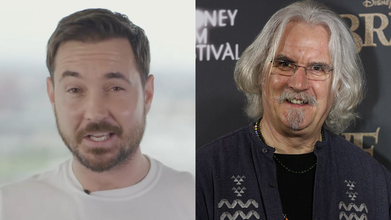- Health Conditions A-Z
- Health & Wellness
- Nutrition
- Fitness
- Health News
- Ayurveda
- Videos
- Medicine A-Z
- Parenting
Neeraj Chopra May Undergo Surgery in Germany

Neeraj Chopra (Credit: X)
India's Olympic silver medalist Neeraj Chopra is likely to undergo surgery for a persistent groin injury. The athlete, who clinched the silver in the men's javelin final, has been battling a hernia that has been causing him discomfort in the groin area. Chopra has now traveled to Germany for further evaluation to ensure the injury doesn't affect his performance in upcoming tournaments. He is reported to stay there for a month now.
What Is Hernia?
A hernia occurs when an organ, typically part of the intestines, protrudes from its normal location. The most common type is an inguinal hernia, where abdominal tissue, like fat or intestines, pushes through a weak spot in the lower abdominal wall, extending into the groin.Notably, there are three types of Hernia:
- Inguinal Hernia: Occurs when abdominal tissue, such as intestines or fat, protrudes through a weak spot in the lower abdominal wall, often extending into the groin. More common in men, it may present as a bulge in the groin that worsens with activity.
- Hiatal Hernia: Happens when part of the stomach pushes up through the diaphragm into the chest cavity. It can cause symptoms such as heartburn, chest pain, and difficulty swallowing. Hiatal hernias are often associated with gastroesophageal reflux disease (GERD).
- Umbilical Hernia: Develops when abdominal tissue bulges through an opening in the abdominal wall near the belly button. Common in infants, it can also occur in adults, particularly those who are overweight or have a history of multiple pregnancies.
Inguinal hernias, from which Chopra is surrfering, are more common in males, affecting 20% of men during their lifetime, compared to only 2% of women. Dr Ajay Kumar Kriplani of Fortis Memorial Research Institute explains that in 20% of cases, hernias can occur on both sides simultaneously.
Symptoms of Hernia
- Groin Bulge: Often noticeable, worsening with coughing and decreasing when lying down.- Discomfort: Typically painless, but mild discomfort may occur.
- Surgical Importance: Experts stress the need for surgical intervention to avoid complications.
- Procedure Methods: Surgery is commonly performed using laparoscopic or robotic techniques.
Billy Connolly Has Been “Incredibly Brave” in His Battle With Parkinson’s Disease, Says Actor Martin Compston

(L) Martin Compston (R) Billy Connolly
Billy Connolly Parkinson's Disease: Martin Compston, Sottish actor and former footballer praised Sir Billy Connolly, actor, comedian and musician, for handling his Parkinson's disease in an "incredibly brave" way.
The 83-year-old comedian was diagnosed in 2013, and five years post that, in 2018, he announced his retirement. Compston who is also co-host of Hoolie In The Hydro, said that the Scottish comedian battled the disease "with a smile on his face and cracking jokes that only Billy can."
He said, "Obviously, Billy’s been battling Parkinson’s but he’s been battling incredibly bravely and again he’s done it with a smile on his face and cracking jokes that only Billy can. I’m hoping he’s with us for a long time to come.”
Billy Connolly Health Update
In 2024, Billy made an admission about death amid his ongoing health struggles. In his 2023 autobiography, he mocked the "exaggerated" reports of his "demise". However, the actor-comedian said that he has maintained a positive outlook about his health and that he does not feel "close to death".
In an interview with The Mirror, he said that he remembers the day when he was told he had Parkinson's was the same day he was diagnosed with prostate cancer. "Yes, it was a funny week I had. On the Monday, I had hearing aids. On the Tuesday I got pills for heartburn, which I have to take all the time, and on the Wednesday, I got news that I had prostate cancer and Parkinson’s."
He shared that the best way to deal with such a news is to start thinking about the next step, which is the treatment. "You just have to think. Don't think you are being badly treated [by life] or you have the bad pick of the straws. You are one of millions. Just behave yourself and relax."
Connolly got the all-clear from prostate cancer after receiving treatment, reported the Independent.
Read: Can You Detect Dementia With An Eye Test?
As far as Parkinson's is concerned, his wife, Pamela Stephenson had said that her husband had the "most significant" symptom of the disease, which was a "couple of serious falls" that happened after his balance deteriorated due to Parkinson's.
Talking to Guardian, Billy said, "Recently I've noticed a deterioration in my balance. That was never such a problem before, but in the last year that has come and it has stayed. For some reason, I thought it would go away because a lot of the symptoms have come and gone away."
Prostate Cancer And Parkinson's Disease In Men Aged 40-50
The John Hopkins Medicine recommends screening for prostate cancer at age 55, and start their PSA screening between ages 40 to 54.
What Is Prostate Cancer? Prostate cancer is the most commonly diagnosed cancer in men and the second leading cause of cancer-related deaths in the United States. In many cases, it grows slowly, and detecting or treating it before symptoms appear may not always improve health outcomes or extend life. Learn more about prostate cancer, including screening, prevention, treatment options, research, and key statistics.
The National Institute of Neurological Disorders and Stroke says that while an average age of onset of Parkinson's disease in a person is in early to mid 60s, there could be some people who may have the disease before the age of 50.
In fact, a 2019 study in the Journal of Parkinson's Disease notes that while the mortality rate of Parkinson's disease is higher in women, risk of developing it is twice as high in men than women.
What Is Parkinson's Disease? Parkinson’s disease is a slowly progressing disorder that affects movement and the nervous system. It develops when certain nerve cells in the brain weaken, become damaged, or die. As a result, people may experience tremors, stiffness, slowed movement, and balance problems. Over time, these symptoms can make everyday activities like walking, talking, and simple tasks more difficult.
Influenza A: After Three Child Deaths, Health Officials Urge Flu Vaccination in Canada

Credits: Canva
Three children from Ottawa and Eastern Ontario have died due to flu-related complications over the past two weeks, as an unusually early and aggressive flu season grips the region. Health officials have confirmed that the cases are linked to Influenza A, a strain currently circulating widely and affecting children more severely than usual, as per CTV news.
The children were between five and nine years old. Authorities have not released further personal details about the two Ottawa cases and one case from Eastern Ontario.
What Is Influenza A?
Influenza A is a fast-spreading respiratory virus responsible for seasonal flu outbreaks and, at times, global pandemics. It changes quickly through genetic shifts, which makes new strains harder to predict and control. The virus is grouped based on surface proteins called hemagglutinin and neuraminidase, with H1N1 and H3N2 among the most common strains in circulation. It spreads mainly through coughs, sneezes, or close contact and often comes on suddenly, causing fever, cough, body pain, and extreme tiredness. In some cases, it can lead to serious complications, especially in vulnerable groups.
Influenza A: Health Officials Call Deaths a Serious Warning
Public health leaders from Ottawa and Eastern Ontario described the deaths as a troubling reminder of how dangerous the flu can be, especially for children.
“This highlights that influenza is not always a mild illness. It can lead to serious complications that require hospitalization,” medical officers of health from both regions said in a joint statement issued on Monday, as per CTV News.
Influenza A: Child Flu Deaths Rare but Not Unprecedented in Canada
While flu-related deaths among children are uncommon in Canada, they are not unheard of. During the last severe flu season in 2022, two children in Ottawa died due to influenza.
Most flu-related deaths in Canada occur among older adults. Of the estimated 3,500 flu deaths reported nationwide each year, roughly 90 percent involve people over the age of 65. However, experts say the current Influenza A strain is behaving differently.
Influenza A Hitting Children Hard This Season
The strain of Influenza A currently circulating has been linked to a sharp rise in severe pediatric flu cases globally. Health officials say the cluster of three child deaths within such a short period, and within a relatively small geographic area, is highly unusual.
This unusual pattern prompted the regional coroner to alert public health authorities after three sudden, unexpected child deaths tested positive for Influenza A.
“It’s rare for the coroner to reach out like this,” said Dr. Trevor Arnason, Ottawa’s medical officer of health. “But this season has been particularly severe.”
Influenza A: Hospitals Strained as Pediatric Cases Rise
CHEO, Ottawa’s children’s hospital, has reported high numbers of children falling seriously ill with the flu since November. Hospitalizations have continued to rise through early December.
Last week, CHEO issued an urgent request asking family doctors to extend clinic hours and assist at the hospital’s Kids Come First clinic to help manage patient volumes.
Hospital officials have also noted that many children arriving at the emergency department with severe flu symptoms had not been vaccinated.
Influenza A: Strong Push for Flu Vaccination as Cases Surge
Public health officials, including Ontario’s Chief Medical Officer of Health Dr. Kieran Moore, are urging everyone aged six months and older to get vaccinated as soon as possible.
Dr. Arnason and Dr. Paul Roumeliotis, medical officer of health and CEO of the Eastern Ontario Health Unit, stressed that vaccination is especially important for children this season.
Influenza A: Vaccine Still Effective Despite Strain Mutation
Some people have expressed concern after reports suggested this year’s flu vaccine is not a perfect match for the circulating Influenza A strain. Health officials clarified that while the virus has mutated slightly since circulating in the southern hemisphere, the vaccine still offers meaningful protection.
“The flu vaccine may not always prevent infection, but it significantly reduces the risk of severe illness, hospitalization, and complications,” officials said. They added that the vaccine takes about two weeks to become fully effective, making early vaccination crucial ahead of the holiday season, when virus spread typically increases.
You're Breathing Your Way Into Diabetes

© 2024 Bennett, Coleman & Company Limited

